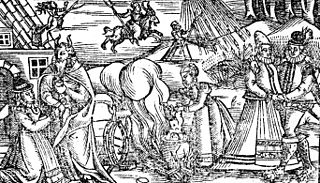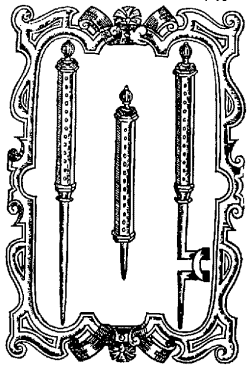Christian Caldwell aka John Dickson | |
|---|---|
| Citizenship | Scottish |
| Years active | 1660s |
| Known for | Witch-hunter |
Christian Caldwell (Caddell) was a cross-dressing witch-hunter active in Morayshire, Scotland during the 1660s.
Contents

Christian Caldwell aka John Dickson | |
|---|---|
| Citizenship | Scottish |
| Years active | 1660s |
| Known for | Witch-hunter |
Christian Caldwell (Caddell) was a cross-dressing witch-hunter active in Morayshire, Scotland during the 1660s.

Caldwell signed a contract with the shire of Moray (Elgin) under her alias John Dickson, . [1] Her true identity is unknown but as witch-pricking was a trade for men she disguised herself as a man to pursue her career.
Caldwell formed her first contract with the Baillie of Spynie, John Innes, and was granted to live in the shire for one year and in turn would identify witches for a salary of 6 shillings a day. [2] A practice for her identification of witches was testing for the devil's mark:
"[A] spot on the body where a pin could be slipped in without bleeding or pain". [1]
Isobel Gowdie, a Scottish woman who confessed to witchcraft at Auldearn near Nairn during 1662, might have been one of her victims. [1] The practice involved stripping and shaving the victim completely and pushing the pin in repeatedly until the right spot was found.
In Tain she wrongly accused John Hay, an influential court messenger who ordered her arrest. [1] Dickson was accused of witchcraft and interrogated in Edinburgh on 30 August 1662 on the basis of "false accusation, torture, and causing death of innocent people in Moray". [2] Her true gender was discovered. She was banished to a fever-subjected plantation in Barbados on 4 May 1663, the day her last victim was burnt in Forres. [1]

Isobel Gowdie was a Scottish woman who confessed to witchcraft at Auldearn near Nairn during 1662. Scant information is available about her age or life and, although she was probably executed in line with the usual practice, it is uncertain whether this was the case or if she was allowed to return to the obscurity of her former life as a cottar’s wife. Her detailed testimony, apparently achieved without the use of violent torture, provides one of the most comprehensive insights into European witchcraft folklore at the end of the era of witch-hunts.

A witch's mark, devil's mark or stigma diabolicum was a bodily mark that witch-hunters believed indicated that an individual was a witch, during the height of the witch trials. The beliefs about the mark differed, depending on the trial location and the accusation made against the witch. Use of the term is found earliest in the 16th century, and reaching its peak in 1645, but then essentially disappearing by 1700.

The North Berwick witch trials were the trials in 1590 of a number of people from East Lothian, Scotland, accused of witchcraft in the St Andrew's Auld Kirk in North Berwick on Halloween night. They ran for two years, and implicated over 70 people. These included Francis Stewart, 5th Earl of Bothwell, on charges of high treason.

The Bideford witch trial resulted in hangings for witchcraft in England. Temperance Lloyd, Mary Trembles and Susannah Edwards from the town of Bideford in Devon were tried in 1682 at the Exeter Assizes at Rougemont Castle. Much of the evidence against them was hearsay, although there was a confession by Lloyd, which she did not fully recant even with her execution imminent. These women have been labelled as the last witches to be hanged in England, but there are subsequent cases which are not as well documented.

In early modern Scotland, in between the early 16th century and the mid-18th century, judicial proceedings concerned with the crimes of witchcraft took place as part of a series of witch trials in Early Modern Europe. In the late middle age there were a handful of prosecutions for harm done through witchcraft, but the passing of the Witchcraft Act 1563 made witchcraft, or consulting with witches, capital crimes. The first major issue of trials under the new act were the North Berwick witch trials, beginning in 1590, in which King James VI played a major part as "victim" and investigator. He became interested in witchcraft and published a defence of witch-hunting in the Daemonologie in 1597, but he appears to have become increasingly sceptical and eventually took steps to limit prosecutions.

The great Scottish witch hunt of 1649–50 was a series of witch trials in Scotland. It is one of five major hunts identified in early modern Scotland and it probably saw the most executions in a single year.
Margaret Bane also called Clerk, was a Scottish midwife and prominent victim of The Great Scottish Witch Hunt of 1597.

The Pittenweem witches were five Scottish women accused of witchcraft in the small fishing village of Pittenweem in Fife on the east coast of Scotland in 1704. Another two women and a man were named as accomplices. Accusations made by a teenage boy, Patrick Morton, against a local woman, Beatrix Layng, led to the death in prison of Thomas Brown, and, in January 1705, the murder of Janet Cornfoot by a lynch mob in the village.

Margaret Aitken, known as the Great Witch of Balwearie, was an important figure in the great Scottish witchcraft panic of 1597 as her actions effectively led to an end of that series of witch trials. After being accused of witchcraft Aitken confessed but then identified hundreds of women as other witches to save her own life. She was exposed as a fraud a few months later and was burnt at the stake.

The Bute witches were six Scottish women accused of witchcraft and interrogated in the parish of Rothesay on Bute during the Great Scottish Witch Hunt of 1661–62. The Privy Council granted a Commission of Justiciary for a local trial to be held and four of the women – believed by historians to be Margaret McLevin, Margaret McWilliam, Janet Morrison and Isobell McNicoll – were executed in 1662; a fifth may have died while incarcerated. One woman, Jonet NcNicoll, escaped from prison before she could be executed but when she returned to the island in 1673 the sentence was implemented.
Marie Lamont, also referred to as Mary Lawmont (1646–1662), was executed for witchcraft during the reign of Charles II just after Witchmania had peaked in the United Kingdom. Her youth at the time of her execution made her case unusual.
Janet Boyman, also known as Jonet Boyman or Janet Bowman, was a Scottish woman accused of witchcraft; she was tried and executed in 1572 although the case against her was started in 1570. Her indictment has been described by modern-day scholars, such as Lizanne Henderson, as the earliest and most comprehensive record of witchcraft and fairy belief in Scotland.
Beatrix Leslie was a Scottish midwife executed for witchcraft. In 1661 she was accused of causing the collapse of a coal pit through witchcraft. Little is known about her life before that, although there are reported disputes with neighbours that allude to a quarrelsome attitude.
Euphame MacCalzean was a victim of the North Berwick witch trials of 1590–1591.
Violet Mar was a Scottish woman accused of plotting the death of Regent Morton by witchcraft.
Margaret Dunholm was a Scottish woman from Burncastle near Lauder who was accused of witchcraft and executed in 1649.
Katherine Campbell was a maidservant accused of theft and witchcraft during the last major witch hunt in Scotland, the Paisley witch trials.

James Grant, 7th of Freuchie (1616–1663) was a Scottish landowner, the seventh Laird of Freuchie. He was the 18th Chief of Clan Grant.
Issobell Fergussone or Isobel Ferguson was a Scottish woman who confessed to witchcraft in Dalkeith, Edinburgh during the year 1661.
Marioun Twedy or Marion Tweedy was accused of witchcraft in Peebles in the Scottish Borders in 1649. She was accused of causing the death of a woman and her child and of using charms to cure animals. She refused to confess to these accusations. However, the witchpricker condemned her for finding 'the devil's mark' on her.